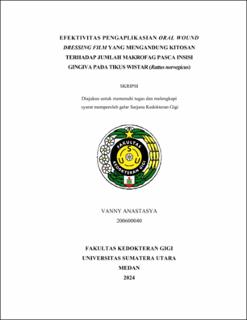| dc.description.abstract | Periodontal surgical treatment is an invasive procedure that opens or exposes parts of
the body's tissues, which typically results in either open or closed wounds. Open
wounds can lead to tissue tearing, potentially causing bleeding, swelling, infection, and
scar formation if not properly addressed. Therefore, periodontal dressing is needed to
cover the wound and minimize the risk of infection. The incision wound resulting from
periodontal surgical procedures is typically treated with periodontal pack as a
periodontal dressing. Commonly available periodontal packs are chemically based,
causing discomfort during use and disrupting aesthetics. Preparations in the form of a
film can be considered an alternative option for oral wound dressing, which is
perceived as more aesthetic, comfortable to use, and easier to apply to tissue surfaces
due to their good adhesive and flexible properties. Therefore, they can protect the
wound surface, reduce pain, and control bleeding. Chitosan is effective in accelerating
wound healing because it possesses mucoadhesive, bioactive, biocompatible,
biodegradable, antimicrobial, and nontoxic properties compared to other polymers.
Chitosan can serve as an anti-inflammatory agent, hemostat, excellent drug carrier, and
can stimulate cell proliferation and remodeling. The purpose of this research is to
determine the effectiveness of oral wound dressing film containing chitosan in
increasing the number of macrophages in the post-gingival incision wound healing
process in Wistar rats. This study is a laboratory experimental research in vivo with a
post-test control group design to measure clinical parameters using the Landry healing index and histological parameters by observing the number of macrophages. The
sample consisted of 45 healthy male Wistar rats aged 2-3 months. The results of this
study indicate that chitosan Oral Wound Dressing Film (OWDF) is effective in
accelerating the wound healing process post-gingival incision in Wistar rats by
increasing the number of macrophages on the 3rd day and decreasing the number of
macrophages on the 7th and 14th days. | en_US |


